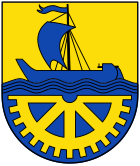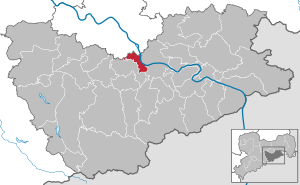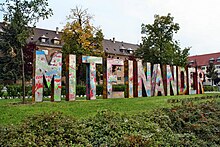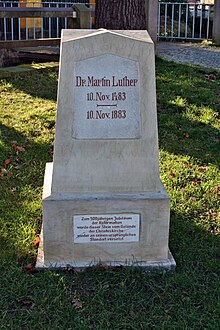Heidenau (Saxony)
| coat of arms | Germany map | |
|---|---|---|

|
Coordinates: 50 ° 58 ' N , 13 ° 52' E |
|
| Basic data | ||
| State : | Saxony | |
| County : | Saxon Switzerland-Eastern Ore Mountains | |
| Height : | 121 m above sea level NHN | |
| Area : | 11.07 km 2 | |
| Residents: | 16,540 (Dec 31, 2019) | |
| Population density : | 1494 inhabitants per km 2 | |
| Postcodes : | 01801-01809 | |
| Area code : | 03529 | |
| License plate : | PIR, DW, FTL, SEB | |
| Community key : | 14 6 28 160 | |
City administration address : |
Dresdner Strasse 47 01809 Heidenau |
|
| Website : | ||
| Mayor : | Jürgen Opitz ( CDU ) | |
| Location of the town of Heidenau in the Saxon Switzerland-Eastern Ore Mountains district | ||
Heidenau is a town in the Saxon Switzerland-Eastern Ore Mountains district in Saxony . It is located in the Upper Elbe Valley at the mouth of the Müglitz and the Elbe . Heidenau borders the state capital in the southeast of Dresden . With around 17,000 inhabitants on eleven square kilometers, Heidenau has the third largest population density of all Saxon communities.
geography
Heidenau consists of the districts of Gommern , Großsedlitz , Heidenau-Süd , Kleinsedlitz , Mügeln and Wölkau .
history
First mention up to modern times
The city corridor was settled in prehistoric times . Large excavated grave fields from the Bronze Age testify to the ancient settlement area. The Heidenau area has been populated by Slavs since around the 7th century .
The first documentary evidence of the town of Gommern comes from the year 1288. Mügeln and Heidenau were first mentioned in documents in 1347/49, Großsedlitz in 1412, Wölkau in 1420 and Kleinsedlitz in 1501.
Heidenau was a quiet farming village until the late 19th century. Probably the Dohna burgrave Otto Heyde founded the village as an outbuilding of the castle . The traditional village names in the 14th century Heydenowe and Heydenaw indicate this.
The village of Meuscha , located in the area of the city limits to Dohna , fell into desolation during the Thirty Years War, except for a single property that was used until the 19th century. The Meuschaer Höhe field name was retained.
While Heidenau, which was first mentioned in a document in 1347, remained dominated by agriculture until the beginning of the 19th century, one of the most important baroque gardens in Saxony is located in Großsedlitz . In 1719, Count August Christoph von Wackerbarth bought the manor Kleinsedlitz and large parts of the surrounding area and built a palace complex, the Friedrichschlösschen Großsedlitz . In 1723 he sold it to the Elector Friedrich August I of Saxony, known as August the Strong .
Industrial age until the Weimar Republic
In 1848 the current district of Mügeln was connected to the Tetschen – Dresden railway line , which led to the emergence of the first industrial companies in the region. In 1890 the Müglitztalbahn leading to Altenberg (Ore Mountains) was opened. By the beginning of the 20th century, cellulose and paper factories, machine and metal goods manufacturing companies, electricity and electric motor factories, network and ink factories as well as chemical and photochemical industries were established.
Today's Heidenau was formed in 1920 from the villages of Mügeln , Heidenau and Gommern . In 1923 the town of Großsedlitz was incorporated, and the following year the community received town charter . Heidenau was chosen as the name of the city because the vast majority of industrial companies had their headquarters on the Heidenauer Flur and were opposed to a name change. In 1933 the Kleinsedlitz district was added, and Wölkau in 1950 .
Heidenau suffered severe damage during the floods in the Osterzgebirge in 1927 .
time of the nationalsocialism
At the beginning of the National Socialist era , political opponents and otherwise undesirable people were persecuted. One of them was the communist Fritz Gumpert , who was taken to the early Königstein- Halbestadt concentration camp in April 1933 , where he was tortured to death by SA men . Photos of the brutally tortured man, which were taken after his coffin was opened, reached the European public via Prague and sparked outrage over the Nazi terror.
During the Second World War , the Elbtalwerke AG requested concentration camp prisoners for their production, who were probably assigned to them. A branch of the Flossenbürg concentration camp was located in Heidenau. On the last day of the war, May 8, 1945, there was a devastating bomb attack on Heidenau, in which 40 people died. 32 houses were destroyed, 412 buildings, some badly damaged.
German Democratic Republic
On July 1, 1950, the previously independent community of Wölkau was incorporated.
To DDR -times several new areas were built. Nevertheless, the considerable housing shortage could not be eliminated during this time. Heidenau was an important industrial location between Dresden and Pirna. Today a paper factory , a malt factory, a furniture factory, a DEA tank farm, several machine factories and tire production companies ( Heidenau tire factory ) are among the town's most important employers.
History after 1989
In the 1990s, Heidenau was hit hard by the extensive decline in industry in East Germany and a high unemployment rate. The industrial wastelands and factory ruins, as well as the conditions prevailing at the central train station at the time, have had a lasting impact on Heidenau's reputation in large parts of the surrounding towns and villages. At the time, a Wertkauf was built on the B 172 , the halls of which will then be used by Wal-Mart and currently by Real , as well as a scooter furniture store in the immediate vicinity , opposite a Praktiker hardware store and an interior design store. An attempt was made to compensate for the social upheavals of the 1990s. The beginnings of successes can already be seen, but the city still has to do with many social and economic problems, which have, however, already been considerably alleviated compared to the period from 1990 to 2002. Heidenau is strategically located between Pirna, Dohna and Dresden, so that the nearest cities, production companies and dealers are very easy to reach. The good connection to the public and road transport network gives many people who want to live centrally and cheaply and z. Going to work, for example, in Pirna , in the Müglitztal , especially Glashütte or Dresden , good conditions. In Heidenau itself, a lot of small businesses and crafts are also emerging .
In August 2002 the floods of the Müglitz wreaked havoc on Heidenau. Due to the Elbe floods that followed shortly afterwards, several parts of the city were under water. Since gas pipes were being replaced at this point and the pipe network was open in several places, large parts of the gas pipe network were flooded and the gas supply had to be interrupted for several days. To protect against flooding, a flood protection dam was built next to an industrial railway embankment on the Elbe , which is open at the entrances to the Elberadweg and can be closed in the event of a flood. This prevented major damage from the winter floods in 2005, for example.
The Max-Leupold-Stadion was also inundated by the floods and in the following years the adjacent cycling track , which filled with water and had to be demolished and rebuilt, and the surrounding area were rebuilt. In 2005 the area was inaugurated as a "sports forum".
Since the city was made up of several villages, there was no market place. Therefore, from July 2006, the area between Bahnhofstrasse and Brunneneck was converted into a market square, which is not shown as such on maps. The town house was built on the market square, in which, among other things, the tourist information and the Heidenau home and culture association have their domicile.
The town hall , built in 1910, has been modernized for around 15 months since September 2011. On February 23, 2013, an open day was held in the town hall to conclude the construction work .
At the end of March 2012, the 64-year-old mayor Michael Jacobs announced that he would resign at the end of the year. Jacobs had been mayor of the city for around 22 years. Jürgen Opitz ( CDU , until then first alderman), Steffen Wolf ( left ), Norbert Bläsner ( FDP ) and Michael Schürer (Heidenauer Bürgerinitiative, HBI) stood for mayoral election on October 7, 2012 . Jürgen Opitz won the election with 58.1 percent of the vote.
On January 26, 2014, the Luther Church was deedicated as part of a service. This had become necessary due to austerity measures. On February 9, the parish was united with the parishes of Dohna and Burkhardswalde to form the parish of Heidenau-Dohna-Burkhardswalde, which was necessary due to the deletions and cuts in the Evangelical Lutheran Church of Saxony .
On August 21, 2015, following a demonstration registered by the right-wing extremist NPD , in which around 1,000 people took part, xenophobic riots against the accommodation of asylum seekers . When a right-wing mob tried to prevent the newly built emergency shelter from moving into by blocking the road, 31 police officers were injured. Members of the right-wing terrorist " Freital Group " were also involved in the riots . In the following two nights there were also riots by right and left groups. Leading people from state and federal politics sharply condemned the riots.
Population development
|
|
||||||||||||||||||||||||||||||||
| Source: State Statistical Office of the Free State of Saxony | |||||||||||||||||||||||||||||||||
politics
City council
Since the municipal council election on May 26, 2019 , the 22 seats of the city council have been distributed among the individual groups as follows (distribution in brackets before changes in party membership):
- CDU : 6 seats
- AfD : 5 seats
- Left : 3 seats
- FDP : 2 seats
- Heidenauer Citizens' Initiative (HBI): 1 seat
- SPD : 1 seat
- Greens : 1 seat
- BOD : 1 seat
Town twinning
-
 Troisdorf (North Rhine-Westphalia, Germany)
Troisdorf (North Rhine-Westphalia, Germany) -
 Benešov nad Ploučnicí (Czech Republic)
Benešov nad Ploučnicí (Czech Republic) -
 Lwówek Śląski (Poland)
Lwówek Śląski (Poland)
In 2004, Heidenau won the “Family-Friendly Community of Saxony” competition from the Saxon State Ministry for Social Affairs. Heidenau has been certified with the “ European Energy Award ” since 2010 and is an energy-saving city.
Culture and sights
- see also: List of cultural monuments in Heidenau
Culture
In 1905 the company Beckmann & Weis Luxusglaswerk was founded by Johann Wilhelm Beckmann and Franz Konrad Weis in Mügeln (today Heidenau), which was carried out in the style of Émile Gallé (born May 4, 1846 in Nancy; † September 23, 1904 in Nancy) especially vases and art objects made of glass. In 1915 the company was continued under the name Eichhorn & Weis GmbH until it was converted into Heidenauer Glashütte AG in 1926. Production was discontinued in 1933.
On May 17th, 2008 the MärchenLebensPfad was opened. This consists of several fairy tale stations that are distributed throughout the city and can be hiked on three different routes. Each station focuses on a fairy tale, the text of which is attached to an open metal fairy tale book. The MärchenLebensPfad initially consisted of 17 stations, but has since been expanded to 19 stations. There is also a book of fairy tales, which contains the three routes with all stations and fairy tale texts, and which is available in various municipal institutions. There are regular hikes with a storyteller on the Fairy Tale Life Path .
Memorials
- Memorial stone on Karl-Liebknecht-Platz by the sculptor Helmut Schwager from 1961 for the victims of fascism
- Mass grave and memorial stone at the Heidenau-Süd cemetery for eleven named prisoners of war and forced laborers who were abducted to Germany during the Second World War and were victims of forced labor
- Memorial stone on the eponymous square for the murdered anti-Nazi Fritz Gumpert
- Memorial stone for the Soviet soldiers who fell in World War II on Freedom Square
- Memorial stone in the Albert-Schwarz-Bad from the politician Albert Schwarz
Green spaces and recreation
- Großsedlitz baroque garden
- city Park
- Elbe meadows
- Karl Liebknecht Square
- Fritz Gumpert Square
- Freedom Square
Sports
- Albert Black Bath
- Max Leupold Stadium
- Velodrome
- several sports fields
- Heidenauer SV
- Heidenauer Dart Club (HDC)
Economy and Infrastructure
Public facilities
- Heidenau City Library
- Heidenau volunteer fire department
education
-
Elementary schools
- Heinrich Heine Elementary School
- Primary school "Bruno-Gleißberg"
- Astrid Lindgren Elementary School
-
High schools
- High school "JW v. Goethe"
- High schools
-
Special schools
- School to promote learning "Ernst-Heinrich-Stötzner"
-
Others
- Saxon Switzerland Music School V.
traffic
-
Major roads
- Bundesautobahn 17 , to be reached from the junctions Heidenau and Pirna
- State road 172 (formerly B172 )
-
Rail transport
- Müglitztalbahn :
- Elbe Valley Railway :
-
Germany - Czech Republic
- RE 20: Dresden - Heidenau - Pirna - Děčín - Ústí nad Labem - Litoměřice (excursion and hiking traffic, only from the end of March to October or in Advent (only from and to Ústí n. L.) on weekends and public holidays)
-
Bus transport
- A: Train station - Dohna / Heidenau-Großsedlitz (line of the Dreßler travel service in Heidenau)
- B: Bahnhof - Dohna - Borthen (line of the Dreßler travel service)
- H / S: Pirna-Sonnenstein - Pirna - Heidenau - Dresden-Prohlis (route of the regional traffic Saxon Switzerland-Eastern Ore Mountains )
- 65: Heidenau / Dresden-Luga - Dresden-Leuben - Reick - Seidnitz - Blasewitz (line of the Dresden public transport company )
- 86: Heidenau - Dresden-Kleinzschachwitz - Laubegast - Dobritz - Prohlis - Lockwitz - Kreischa (line of the Dresden public transport company)
- 201: Heidenau - Glashütte (line of the Dreßler travel service)
- 202: Heidenau - Maxen (line of the Dreßler travel service)
-
Elbe shipping
- Landing point of the Saxon Steamship Company
- Ferry connection Heidenau - Birkwitz-Pratzschwitz (operated by the regional traffic Saxon Switzerland-Eastern Ore Mountains)
Personalities
sons and daughters of the town
- Ernst Hermann Grämer (* 1899 in Heidenau, † 1966 in Dresden), sculptor
- Woldemar Winkler (* 1902 in Mügeln, † 2004 in Gütersloh), painter, draftsman and sculptor
- Gottfried Voigt (* 1914 in Heidenau, † 2009 in Fredersdorf), Protestant theologian
- Lotte Buschan (* 1917 in Heidenau, † 1994 in Annaberg-Buchholz), singer at the Annaberg Theater
- Ursula Hasse (* 1925 in Heidenau, † 2013 in Heidenau), artist
- Eugen Schönebeck (* 1936 in Heidenau), painter
- Günter Groß (* 1938 in Großsedlitz), engineer and museum director
- Christian Lenz (* 1938 in Heidenau), art historian
- Günter Böhme (* 1943 in Heidenau), functionary of the FDJ and the SED in the GDR
- Max Niederlag (* 1993 in Heidenau), track cyclist
Personalities associated with the city
- Johann Wilhelm Beckmann - entrepreneur: founder of the Beckmann & Weis company in 1905 luxury glass factory
- Franz Konrad Weis - entrepreneur: Founder of Beckmann & Weis in 1905 luxury glass factory
- Max Dünnebier (born November 22, 1878 in Briesnitz , † March 19, 1950 in Neuwied ), German inventor and co-founder of the Winkler & Dünnebier company
- Günter Benser (* 1931), historian
- Siegmar Faust (* 1944), writer and former state representative for the Stasi files in Saxony
- Uwe Müßiggang (born November 5, 1951), coach of the German biathlon women's national team
- Jens Fiedler (born February 15, 1970 Dohna ) track cyclist, Fiedler lived in Heidenau until he was 13 years old
- Norbert Bläsner (* 1980), politician (FDP), MdL
- Oliver Wehner (* 1984), politician (CDU), MdL
literature
- Brockhaus travel guide Dresden / Saxon Switzerland / Eastern Ore Mountains - including Heidenau and Grosssedlitz Baroque Garden, VEB FA Brockhaus Verlag, Leipzig 1965
- Günter Benser : Volksbühne Heidenau 1906 to 1939 - 1945 to 1949. The eventful history of an amateur theater , edition bodoni, Berlin 2007, ISBN 978-3-929390-95-7
- Heimat- und Kulturverein Heidenau (Ed.): Heidenau. The history of the city , Heidenau 2013
- Herbert Koitzsch: Heidenau - Development of a Socialist City , Heidenau 1978
- Alfred Meiche: Historical-topographical description of the Pirna administration. Dresden 1927. ( digitized version )
- Schulförderverein Grundschule Mühlbach (Ed.): Legendary Müglitztal. Old and new stories from Zinnwald to Heidenau , Verlag Niggemann & Simon, Maxen 2003, ISBN 3-9808477-1-3
- Heidenau city archive: Heidenau through the ages , Sutton Verlag, Erfurt 1999, ISBN 3-89702-118-8
- Stadtverwaltung Heidenau (Ed.): Pictures from the past of Heidenau , Geiger Verlag, Horb am Neckar 1991, ISBN 3-89264-590-6
- Herbert Wotte : Baroque garden Großsedlitz / Dohna - Wesenstein - Wilisch , Brockhaus-Wanderheft 99, VEB Bibliographisches Institut, Leipzig 1961
Web links
|
Further content in the sister projects of Wikipedia:
|
||
|
|
Commons | - multimedia content |
|
|
Wiktionary | - Dictionary entries |
- Website of the city of Heidenau
- Heidenau in the Digital Historical Directory of Saxony
Individual evidence
- ↑ Population of the Free State of Saxony by municipalities on December 31, 2019 ( help on this ).
- ↑ a b c story. City of Heidenau, accessed on December 25, 2016 .
- ^ Christine O'Keefe: Concentration Camps.
- ↑ Ralf Hübner, Jörg Schurig: Unleashed hatred - and 31 injured police officers. In: Welt Online . August 22, 2015, accessed December 25, 2016 .
- ↑ Ndr: "Lausbuben": How to play down terrorists in Freital. In: daserste.ndr.de. January 29, 2015, accessed December 15, 2017 .
- ↑ Doreen Reinhard: Heidenau: The next level of violence. In: Zeit Online . August 23, 2015, accessed December 25, 2016 .
- ↑ Renewed violence: riot between left and right in Heidenau - police use irritant gas. In: Focus Online . August 24, 2015, accessed December 25, 2016 .
- ↑ Results of the 2019 city council election
- ↑ Heidenaus participant profile at the European Energy Award ( Memento of the original from December 25, 2016 in the Internet Archive ) Info: The archive link was inserted automatically and has not yet been checked. Please check the original and archive link according to the instructions and then remove this notice.
- ↑ http://www.heidenau.de/Freizeit-Tourismus/Freizeit/Vereine/index.php?ModID=9&object=tx%7C2458.36&FID=2458.214.1&NavID=2458.15&La=1
- ↑ a b History of the company 19 Beckmann & Weis Luxusglaswerk













